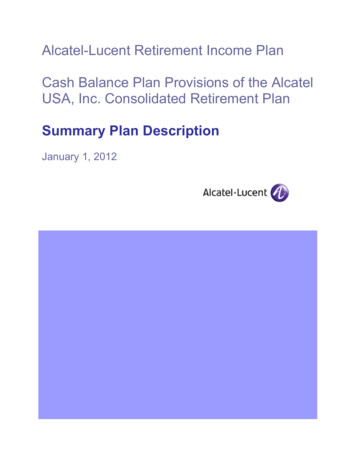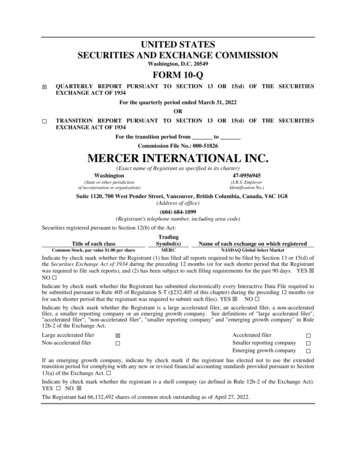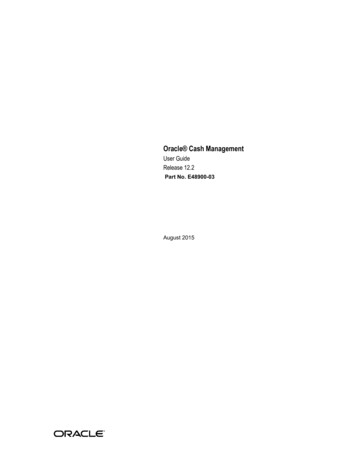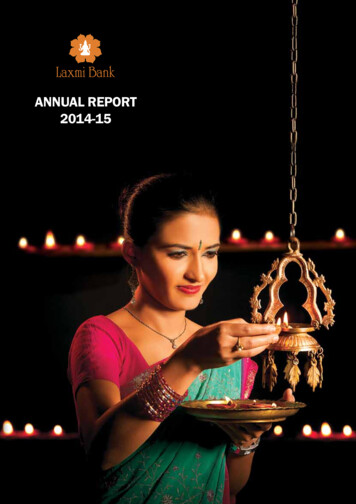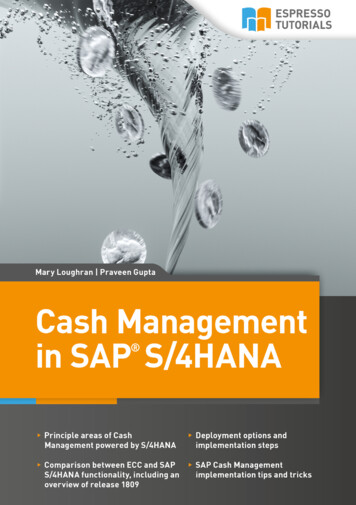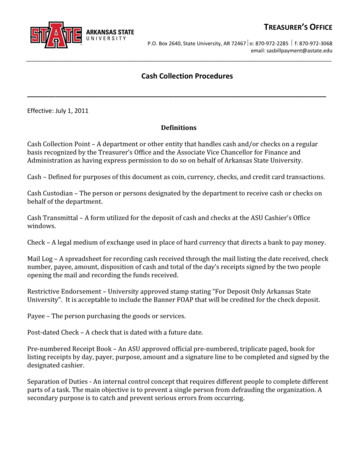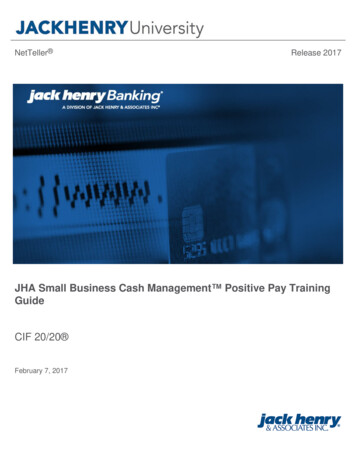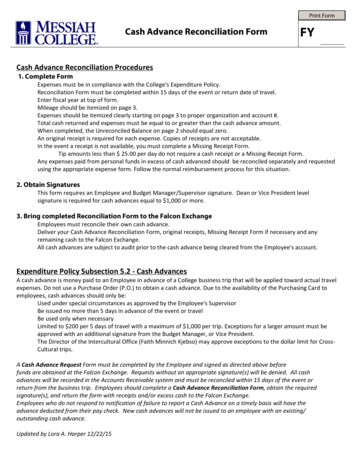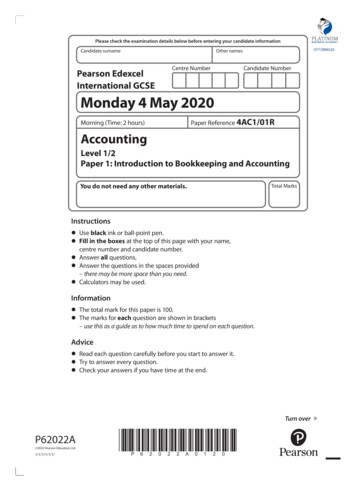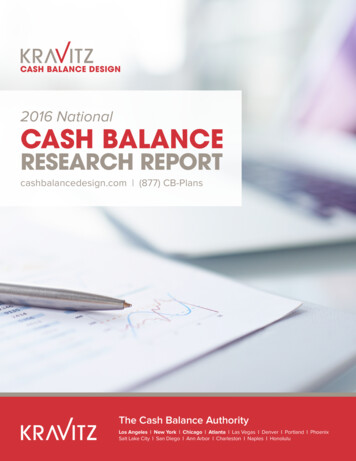
Transcription
2016 NationalCASH BALANCERESEARCH REPORTcashbalancedesign.com (877) CB-PlansThe Cash Balance AuthorityLos Angeles New York Chicago Atlanta Las Vegas Denver Portland PhoenixSalt Lake City San Diego Ann Arbor Charleston Naples Honolulu
Cash Balance Plans Increase 19%,Total Assets Now Surpass 1 TrillionHigher taxes and the need to catch up on retirement savingsmotivates business owners to add Cash Balance plansEvery year since 2008, Kravitz has published an in-depth analysis of the latest IRS Form 5500filings for Cash Balance retirement plans. The annual growth in new plans, regional trends, assetgrowth and other statistics are provided as a reference for retirement plan professionals andothers interested in learning more about Cash Balance plans.Highlights: The number of new Cash Balance plans increased 19% compared with just 2% for 401(k)plans: Continuing almost a decade of double-digit annual growth, the Cash Balance planmarket was up 19% in 2014, the most recent year for which complete DOL data is available.In contrast, the number of new 401(k) plans rose only 2%. Market volatility and economic uncertainty have not slowed Cash Balance growth: Despite a highly volatile market and global economic concerns, the adoption of new CashBalance plans has continued to accelerate. Between 2008 and 2014, there was a 189%increase in new plans nationwide. Cash Balance plan assets reached 1 Trillion nationwide: Total Cash Balance plan assetsreached 1T for the first time in 2014, a key indicator of their growing importance in theretirement plan marketplace. Plan sponsors added 25B in contributions in 2014. Cash Balance plans make up 29% of all defined benefit plans, compared with 2.9% in2001: The rise of Cash Balance plans has coincided with a steady decline in traditionaldefined benefit plans due to ongoing risk issues and cost volatility. Small and mid-size businesses are the engine for Cash Balance growth: 91% of CashBalance plans are in place at firms with fewer than 100 employees. New IRS regulations in 2010 and 2014 drove Cash Balance growth by allowing broaderinvestment options and minimizing funding issues: The 2010 and 2014 IRS Cash Balanceregulations allowed for Actual Rate of Return and other investment options, making the plansmore flexible and appealing to employers.*Source: Analysis performed by Kravitz, Inc., using data from IRS Form 5500 filings via the Judy Diamond Associates, Inc. database. The 2014plan year data is the most current complete data set available. Additional data on defined contribution and defined benefit plans comes fromPrivate Pension Plan Bulletin Abstracts by the U.S. Department of Labor Employee Benefits Security Administration (EBSA), 2001 – 2013. Kravitz, Inc., 2016. The information in this report is general in nature and provided for informational purposes only.1
Table of ContentsIntroduction & Research Highlights1Cash Balance Plans: Growth 2001 to 20153The popularity of Cash Balance plans has soared since 2001, with double-digit annual growth each year.Cash Balance Plans as a Percentage of All Defined Benefit Plans4In just over a decade, Cash Balance plans have increased from 2.9% to 29% of all defined benefit plans.Cash Balance Plans by Year Established5The number of Cash Balance plans nationwide has more than tripled since the 2006 Pension Protection Act (PPA).Cash Balance Plans by Size: Participants6Small to mid-size businesses continue to drive the growth of Cash Balance plans throughout the country.Cash Balance Plans: Company Contributions to Employee Retirement Accounts7Companies typically double contributions to employee retirement savings when adding a Cash Balance plan.Cash Balance Plans by Asset Size8Cash Balance plan sponsors contributed 25B in 2014, increasing total assets to 1T nationwide.Largest Cash Balance Plans by Asset Size9Cash Balance plans play a strategic role in benefits planning for many Fortune 500 companies.Interest Crediting Rates Chosen by Cash Balance Plan Sponsors10‘Actual Rate of Return’ has become an increasingly popular choice.Interest Crediting Rates Chosen by Large Cash Balance Plan Sponsors11Larger plan sponsors are turning to investment choice plan designs.Cash Balance Plans by Investment Category12The nation’s 1T in Cash Balance plan assets are invested in a mix of equity and bond fundsCash Balance Plans: Regional Concentration13California and New York continue to lead the Cash Balance sector.Cash Balance Plans by Business Type14America’s healthcare, technical, legal and financial sectors lead the way in adopting Cash Balance plans.Defined Contribution Plans Associated with Cash Balance Plans15Plan combinations allow business owners to optimize tax efficiency and maximize retirement savings.About Kravitz162
Cash Balance Plans:Growth 2001 to ,0002,0005,2444,7971,7423,1742,1881,3372001 2002 2003 2004 2005 2006 2007 2008 2009 201020112012201320142015 ** Projection based on current growth rates and industry data.The popularity of Cash Balance plans has soared since 2001, with double-digit annual growtheach year of the decade and an increase of more than 1,035% in 14 years.What’s behind the remarkable growth in Cash Balance plans? Rising taxes: Rising federal, state and local tax rates have motivated many business ownersto maximize tax-deferred retirement savings and take advantage of tax deductions forcontributions to employee retirement accounts. Hybrid appeal: These “hybrid” plans combine the high contribution limits of a traditionaldefined benefit plan with the flexibility and portability of a 401(k) plan. They also avoid thecommon risk factors and runaway costs involved in traditional defined benefit plans. Legislative changes and broader options for plan sponsors: The 2006 Pension ProtectionAct affirmed the legality of Cash Balance plans and made the plans easier to administer. NewIRS Cash Balance regulations in 2010 and 2014 expanded investment options, minimizingmany funding issues. Retirement savings crisis: Media coverage of the Boomer generation’s lack of retirementpreparedness is prompting older business owners to accelerate savings and maximizequalified plan contributions.3
Cash Balance PlansAs a Percentage of All Defined Benefit 011201220132014In just over a decade, Cash Balance plans have increased from less than 3% to 29% of all definedbenefit plans. Traditional defined benefit plans have been steadily declining since the mid-1980s,due to a complex array of risk issues, runaway costs, and major changes in workforce demographics.Some larger corporations converted existing defined benefit plans to Cash Balance, while hybridplans also became increasingly popular with small to mid-size businesses.Why are Cash Balance plans rapidly replacing traditionaldefined benefit plans? Lower risk: Cash Balance plans remove the interest rate risk that led to constantly changingvalue of liabilities in traditional defined benefit plans. Removing cost volatility: The structure of a Cash Balance plan prevents runaway costs foremployees nearing retirement age. Easier for employees to understand and appreciate: Cash Balance plans are similar to 401(k)plans in terms of showing individual account balances. Some plans even offer participantwebsites with daily updates. Consistency and fairness: These plans allow for more consistent contributions to employees,rather than uneven age-based contributions. Full portability: Account balances can be rolled over to an IRA, a necessary option for today’smobile workforce in which many employees change jobs every few years.4
Cash Balance PlansBy Year Established10,0009,0008,2628,000Number of 9811130Prior to 1985*1985-19893391990-19992000-20052006-2009(Prior to PPA legislation) (Prior to NewCB Regulations)2010-2014(Post NewCB Regulations)* Plans with an effective date prior to 1985 are traditional defined benefit plans that were later converted toCash Balance. The first IRS-approved Cash Balance plan was established in 1985 by Bank of America.The number of Cash Balance plans nationwide has more than tripled since the PensionProtection Act (PPA) came into effect in 2006. The first Cash Balance plan was establishedby Bank of America in 1985, but the emerging hybrid segment of the retirement plan marketremained relatively unknown for the next two decades.How are legislative changes acceleratingthe growth of Cash Balance plans?2006 Pension Protection Act: This law clarified IRS approval of the plans, removed anyremaining uncertainty about their legal status, and introduced other changes that simplifiedimplementation and administration. Thanks to this legislative shift, Cash Balance plans became apopular and viable choice for many small business owners.2010 IRS Cash Balance regulations: New regulations published in 2010 provided greaterclarity and expanded options for Interest Crediting Rates (ICR), making these plans even moreappealing to employers. The new regulations also generated widespread media coverage andgreater national awareness of the high contribution limits, tax advantages and recruitment/retention power of adding a Cash Balance plan.2014 Final IRS Cash Balance regulations: Final regulations issued in September 2014 gave plansponsors a compliance roadmap and greater investment flexibility, including the option to use fixedrates up to 6% and to include multiple investment options within a single Cash Balance plan.5
Cash Balance Plans by Size:ParticipantsParticipantsNumberof PlansPercent ofNation’s TotalOver 10,0002531.7%1,000 to 10,0005753.8%100 to 9995733.8%25 to 991,59310.5%10 to 243,49923.0%1 to 98,68557.2%National Total15,178Total participants in Cash Balance plansnationwide: 12.3 millionSmall to mid-size businesses continue to drive the growth of Cash Balance plans and the highestgrowth over the past five years has been in companies with fewer than 25 employees. Today,91% of plans are in place at firms with fewer than 100 employees. Firms with 1 to 9 employeesnow account for 57% of all Cash Balance plans.The largest plans (those with 10,000 or more participants) typically represent traditional definedbenefit plans that were converted to Cash Balance. These conversions may increase in the nextfew years as an alternative to terminating financially troubled defined benefit plans.What makes Cash Balance plans so attractive to small business owners? Cost efficiency and tax efficiency: After staff costs, taxes are usually the largest expenditure forsmall businesses. Cash Balance plans help owners with a significant tax deduction for employeecontributions, plus generous tax-deferred retirement contributions for themselves. Asset protection: As with any IRS-qualified retirement plan, Cash Balance assets areprotected in the event of a lawsuit or bankruptcy. Catching up on delayed retirement savings: Age-weighted contribution limits allow olderowners to squeeze 20 years of savings into 10. Owners can typically double or triple theirdeferrals compared with a stand alone 401(k). Attracting and retaining talented employees: Defined benefit plans such as Cash Balanceare more appealing to many employees than a typical 401(k) plan, and allow small businessowners to offer a competitive recruitment advantage.6
Cash Balance Plans:Company Contributions to EmployeeRetirement AccountsPlan Type401(k) only*401(k) combined with aCash Balance 6%2.8%3.1%6.2%5.8%6%6.2%6.3%6.3%6.5%Company contributions as a percentage of eligible participants’ total annual payroll.Companies typically double contributions to employee retirementsavings when adding a Cash Balance plan 6.5% of pay – average employer contribution to non-owner employees in companies withboth Cash Balance and 401(k) plans. 3.1% of pay – average employer contribution to non-owner employees in companies with401(k) only.Typically, Cash Balance plans require employers to contribute 5% to 8% of pay to non-highlycompensated employees in order to contribute larger amounts for the owners. This is often morethan double the contribution employees receive at firms with 401(k) alone.Cash Balance plans provide other advantages to employees: Employees do not have to reduce their take-home pay in order to receive an employercontribution, since Cash Balance contributions (sometimes also satisfied through a profitsharing plan) are not based on a “match.” Employees do not have to choose their own investments or bear any investment risk. Plan assets are pooled and typically invested by the plan sponsor using a conservativebenchmark, so retirement savings are protected from market volatility. Portability: When employees leave or retire, they have the choice of an annuity option or alump sum that can be rolled over to an IRA.*Source for data on employer contributions to 401(k) plans, 2008-2014: Plan Sponsor Council of America (PSCA), 58th Annual Surveyof Profit Sharing and 401(k) Plans.** Source for combination plans: analysis of Kravitz clients’ contributions to employee retirement accounts.7
Cash Balance Plansby Asset Size40%35%34%30%25%22%20%18%18%15%10%4%5%3%1% 1BillionMillion 100Million 10- 1BillionMillion- 99.9Million- 9.9 1Million- 999,999 500,000- 499,999 250,000 250,0000%Total assets in all Cash Balance plans nationwide: 1T in 15,178 plansAnnual contributions for 2014: 25.1 BillionTotal Cash Balance assets increased from 952B in 2013 to 1T in 2014. More than 75% of existingCash Balance plans were established within the past nine years, after the 2006 Pension ProtectionAct clarified their legality. As relatively new plans, many still have assets under 500,000. Thisasset profile will shift over the next decade, as many business owners seek to maximize taxdeferred savings for themselves and optimize tax-efficient contributions to employees.For most firms, a Cash Balance plan is an “add-on” to an existing 401(k) profit sharing plan thatalready has significant assets. See page 15 for an overview of the most popular plan combinations.Highlights: steady, stable growth The median asset size of a Cash Balance plan is 476,259; the average is 66 million. 30% of Cash Balance plans have assets over 1 million. Cash Balance accounts increase each year in two ways: through an employer contribution(a flat amount or a percentage of pay) and through an interest credit. Both are specified in theplan document. See page 10 for a discussion of Interest Crediting Rates. The high percentage of plans with assets under 250K reflects the large number of newstart-up plans at small firms, typically with fewer than 10 participants.8
Largest Cash Balance Plansby Asset SizeTop 10 Plans OverallTop 10 Medical/Hospital PlansTop 10 Law Firm Plans1. IBM 56.7B1. Sutter Health 3.6B1. Sidley Austin2. AT&T 54.5B2. MassachusettsGeneral Hospital 3.2B2. Skadden, Arps, Slate, 334.8MMeagher & Flom3. Boeing 30.7B 2.8B4. FedEx 21.3B3. IntermountainHealthcare3. Morgan, Lewis &Bockius4. Shands Healthcare 1.6B4. O’Melveny & Myers 209M 1.3B5. Gibson, Dunn &Crutcher 187.1M5. Alcatel-Lucent 20.4B6. Bank of America 20.0B5. North ShoreUniversity Hospital7. United Technologies 18.9B6. Brigham andWomen’s Hospital 1.2B7. The Cleveland ClinicFoundation 1.2B8. Memorial HermannHealthcare9. Board of Trustees forHospital Employees8. Honeywell International 16.9B9. Northrop Grumman10. 3M 16.6B 16.6B10. MedStar Health Inc. 721.7M 321.8M6. Jones Day 184.7M7. Reed Smith LLP 144.1M8. DLA Piper 142.5M 1.2B9. Kirkland & Ellis LLP 133.2M 1.1B10. Arnold & Porter LLP 130.8M 1.1BCash Balance plans play a strategic role in retirement andbenefits planning for many large firmsWhile the dramatic growth in new Cash Balance plans has been driven mainly by small andmid-size businesses, these tax-efficient plans are also offered by many leading national lawfirms, hospitals, and medical groups. Select Fortune 100 companies maintain large Cash Balanceplans, some of which were converted from older traditional defined benefit plans (see page 4 formore details). For many large firms, Cash Balance plans are a key tool for recruiting and retainingtalented employees in a highly competitive labor market.9
Interest Crediting Rates Chosenby Cash Balance Plan Sponsors5.4%1.3%Interest Crediting RateFixed Rate of Return(ranging from 2% to 5.5%)20.4%56.2%16.7%Percentage*56.2%30-year Treasury Rate16.7%30-year Treasury Ratewith a floor20.4%(ranging from 3% to 4.5%)Actual Rate of Return1.3%Actual Rate of Returnwith ceiling5.4%(ranging from 3% to 6%)‘Actual Rate of Return’ and fixed rates rise in popularityAll Cash Balance plan participants receive an annual interest credit on their account balances,based on the specific Interest Crediting Rate (ICR) written into the plan document.Prior to the new Cash Balance regulations published in 2010, an estimated 95% of Cash Balanceplans used the yield on the 30-year Treasury bond, which averaged 4% to 5% over the past decade.The 2010 IRS regulations allowed many more options. Fixed rates have become the dominantchoice, while Actual Rate of Return is a very popular option for larger plans (see page 11 for details).Actual Rate of Return: this option allows plan sponsors to set the ICR to equal what the planinvestments actually earn in the market (the “Actual Rate of Return”), rather than trying to targeta specific interest rate every year. The employer’s investment risk is reduced considerably, andparticipants are protected by various investment rules.Final IRS Cash Balance regulations released in September 2014 made Actual Rate Return aneven more compelling option, as discussed on page 11.* Based on Interest Crediting Rate (ICR) selections by 672 Kravitz Cash Balance clients.10
Interest Crediting Rates Chosenby Large Cash Balance Plan SponsorsInterest Crediting RatePercentage*Fixed Rate of Return16.7%(ranging from 2% to 5.5%)33.3%41.7%16.7%30-year Treasury Rate41.7%30-year Treasury Ratewith a floor8.3%(ranging from 3% to 4.5%)8.3%Actual Rate of Returnwith ceiling33.3%(ranging from 3% to 6%)Minimizing risks and maximizing investment options makesActual Rate of Return appealing for larger plansSoon after the 2010 Cash Balance regulations allowed plan sponsors to start using Actual Rateof Return as an ICR, we saw a significant shift in the large plan market away from the 30-yearTreasury and toward Actual Rate of Return, typically with a cap between 5% and 6% to managevolatility. The employer’s investment risk is reduced considerably, and participants are protectedby various investment rules, including preservation of capital.The final IRS Cash Balance regulations released in September 2014 made Actual Rate of Returneven more compelling, since plan sponsors can now offer multiple investment options within asingle plan, tailored to suit different retirement goals and needs.Advantages of an Investment Choice Cash Balance plan: Meets diverse participant needs and goals Incorporates a range of investment strategies within a single plan Enhances flexibility for growing firms with many partners/shareholders Improves ability to attract and retain top talent* Based on Interest Crediting Rate (ICR) selections by 24 Kravitz Cash Balance clients with large plans.11
Cash Balance Plan Assetsby Investment Category3%1%Type of InvestmentsPercentage*6%45%45%Equities or Equity Funds45%Bonds or Bond Funds45%Cash or Equivalents6%Balanced Funds3%Alternative Investments1%Plan sponsors and advisors face a challenging investment climateAs discussed on page 10 of this report, Cash Balance plans have an Interest Crediting Rate (ICR)written into the plan document, typically a safe harbor rate between 2%–4% or the “Actual Rate ofReturn” (ARR) on plan assets, with a cap between 5%–6% to manage volatility. Kravitz surveyedthe investment portfolios of 413 Cash Balance plans representing 1.14B in assets. It appears thatdue to the historic low interest rate environment, many plans are taking on considerable equityrisk which may create problems due to overfunding and underfunding.Guidelines for Cash Balance plan investing: With a one-year time horizon for annual actuarial certification and the need to minimizevolatility, Cash Balance plans require a unique investment strategy very different from a 401(k)or a traditional defined benefit plan. This distinction presents an opportunity for financialadvisors who understand the nuances and challenges of Cash Balance plans. High equity exposure in the plan’s portfolio may result in significantly underperforming orover-performing the ICR; instead, a strategically conservative investment approach is advised. Investment performance that exceeds the ICR may reduce future contribution amounts andthereby lower the tax deferral opportunity, and could also incur excise taxes in certain situations. Investment performance below the ICR results in increased future contribution levels,possible benefit restrictions to owners, and the requirement to make up shortfalls to anydeparting participants.*Data based on a sample selection of 413 Cash Balance plans totalling 1.14B in assets.12
Cash Balance Plans:Regional ConcentrationRankStateNumberof PlansPercent ofNation’s TotalPercent onal Total15,178* Increase in total number of plans between 2013–2014, the most recent year for which completeIRS Form 5500 data is available.California and New York have lead the way in the Cash Balance sector for the last decade, andthat trend continues. As of 2014, they account for 3,540 plans, or 23% of the national total. Alongwith California and New York, the fastest regional growth in new plans has been in Texas andFlorida. Both states saw a 23% increase in the number of plans from the previous year.Since new Cash Balance plans are most frequently adopted by successful, profitable small to mid-sizebusinesses, their growth rates are a good indicator of the regional health of small business.Other regional highlights: Each state in the Top 10 showed over 10% growth in total plans from 2013 to 2014 andmore than half had an increase of over 15%. States with high concentrations of medical speciality groups and thriving small businessenvironments typically show the highest annual growth in new Cash Balance plans. The Top 10 states remain the same from last year’s list, with Ohio replacing Illinois at number 3. Georgia, Maryland, Virginia, Massachusetts, and North Carolina are all closing in on theTop 10 with almost 300 plans each.13
Cash Balance Plansby Business sistsioLesnagal, merica’s healthcare, technical, legal and financial sectors continue to lead the way in adoptingCash Balance plans. These plans are an excellent fit for the retirement needs of professionalservices firms, because of their flexibility for multi-partner firms and high age-weighted contributionlimits which allow older owners to double or triple pre-tax retirement savings.Cash Balance plan adoption across diverse business sectors: Manufacturing firms now account for 7% of all Cash Balance plans, a promisingsign for the economy since owners need fairly predictable profit levels to meet theplan’s financial commitments. Medical and dental groups account for 37% of all Cash Balance plans nationally, and weexpect to see continued growth in the healthcare sector as the economy adjusts to therequirements of the Patient Protection and Affordable Care Act (PPACA). With many CPA and financial advisory organizations educating clients about Cash Balanceplans, we expect even greater diversification of business types adding these plans. The “Other” category (10% of all Cash Balance plans) provides a compelling snapshot of thesheer diversity in types of businesses adopting Cash Balance plans. It includes everythingfrom amusement parks to funeral parlors, film producers to auto detailers.14
Defined Contribution PlansAssociated with Cash Balance Plans100%90%95.7%85.5%Percent of CB Plans Associated with DC Plan tSharing0%0.8%403(b)1.6%Plan combinations allow business owners to optimizetax efficiency and maximize retirement savings Very few firms have a stand-alone Cash Balance plan; today 96% offer Cash Balance plans incombination with one or more defined contribution plans. The most common combination isCash Balance with a 401(k) and/or profit sharing plan, allowing business owners to maximizecontribution levels, flexibility and tax efficiency. When a firm offers a combination of retirement plans, the IRS requires “cross-testing” toensure fairness to all employee groups across all compensation levels. It is important to havean experienced, technically skilled actuarial consultant design a Cash Balance retirementprogram that will achieve the plan sponsor’s goals while passing all IRS tests every year. The average employer contribution to staff retirement accounts is 6.5% of pay in companieswith both Cash Balance and 401(k) plans, compared with 3.1% of pay in firms with 401(k) alone(see page 7 for details). Thanks to steadily increasing demand for creative plan designs combining Cash Balance,401(k) and Profit Sharing, top retirement plan consultants are finding new opportunities todevelop a niche specialty with a competitive edge.15
About KravitzSince 1977, Kravitz has brought its clients the latest in design, administration, and management ofcorporate retirement plans. Kravitz designed its first Cash Balance plan in 1989 and has becomenationally recognized as an innovator and a leader in all aspects of Cash Balance plans. Todaythe firm manages more than 1,300 retirement plans across the country, including more than 700Cash Balance plans.Headquartered in Los Angeles, Kravitz has offices in New York, Chicago, and Atlanta, alongwith satellite offices in 11 other states. The Kravitz team of 80 employees includes 11 actuariesand many other highly trained and credentialed retirement professionals. Kravitz founded theCash Balance Coach training program in 2009, the only available Cash Balance certificationprogram. More than 1,100 financial advisors and retirement professionals have enrolled, earningcertification as Cash Balance Consultants. Kravitz has also published a book, Beyond the 401(k),an industry bestseller on the topic of Cash Balance plans as a business growth strategy.Learn more at CashBalanceDesign.com.For more information regarding Cash Balance plans,please contact Kravitz:(877) CB-PlansCashBalanceDesign.comemail@kravitzinc.com Kravitz, Inc., 2016. The information in this report is general in nature and provided for informational purposes only.16
Cash Balance Plans: Company Contributions to Employee Retirement Accounts 7 Companies typically double contributions to employee retirement savings when adding a Cash Balance plan. Cash Balance Plans by Asset Size 8 Cash Balance plan sponsors contributed 25B in 2014, increasing total assets to 1T nationwide. Largest Cash Balance Plans by .
